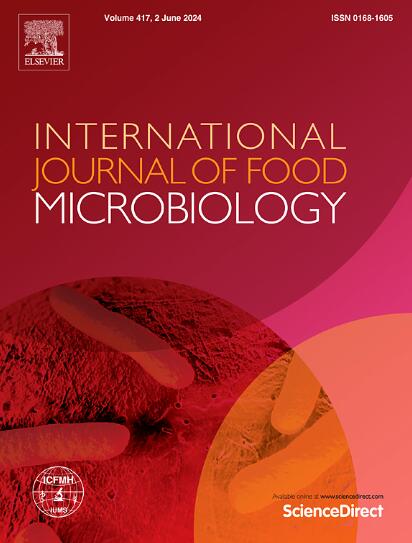Listeria monocytogenes growth under well-controlled CO2, pH, and temperature conditions through a novel gas-controlling system
IF 5
1区 农林科学
Q1 FOOD SCIENCE & TECHNOLOGY
International journal of food microbiology
Pub Date : 2025-07-09
DOI:10.1016/j.ijfoodmicro.2025.111343
引用次数: 0
Abstract
While effectively extending the shelf life of perishable foods at low temperatures by delaying the growth of spoilage microorganisms, modified atmosphere packaging (MAP) may favor the growth of certain pathogens under refrigerated and anaerobic environments. In particular, Listeria monocytogenes poses a major safety concern and has caused a significant increase in foodborne outbreaks over the last five years in EU. Although this pathogen has received great attention in the field of predictive microbiology, the exact relations between its growth and interconnected stress factors (CO2, pH, and temperature) still need to be better understood, calling for extensive data collection. Thus, this study aims to understand the impact(s) of these factors by analyzing the behavior of L. monocytogenes in a liquid medium under well-controlled anaerobic conditions with varying CO2 levels (0–20–40-60 %), pH values (7.7, 6.2), and temperatures (4, 7 °C). Three primary growth models – Logistic, modified Gompertz, and Baranyi – were evaluated to fit the growth data from controlled experiments, performed under anaerobic atmospheres employing an innovative gas-washing bottle incubation system (GBIS). The Baranyi model presented the best growth model to fit the growth data. This study showed that higher CO2 (60 %) individually reduced the maximum growth rate (μmax, 1/day) from 0.32 to 0.21 at 4 °C and from 0.46 to 0.39 at 7 °C. Similarly, lower pH decreased the μmax from 0.40 to 0.32 at 4 °C and from 0.68 to 0.46 at 7 °C. Moreover, decreasing temperature from 7 °C to 4 °C led to a reduction in μmax from 0.68 to 0.40 at pH 7.7 and from 0.46 to 0.32 at pH 6.2, while μmax decreased from 0.39 to 0.21 in the presence of 60 % CO2. In terms of interactions, lower temperature enhanced the growth-reducing effect of higher CO2. The same stressing factor, conversely, reduced the low pH-induced effect on the growth in CO2-free conditions. Similarly, lower pH decreased the growth-reducing effect of lower temperature. These insights highlighted the importance of studying well-controlled experimental conditions when aiming at designing MAP packaging to achieve safe, sustainable packaging solutions.
单核细胞增生李斯特菌通过一种新的气体控制系统在良好控制的CO2、pH和温度条件下生长
虽然通过延缓腐败微生物的生长,可以有效地延长易腐食品在低温下的保质期,但修饰气氛包装(MAP)可能有利于某些病原体在冷藏和厌氧环境下的生长。特别是,单核细胞增生李斯特菌引起了主要的安全问题,并在过去五年中在欧盟引起了食源性疫情的显著增加。尽管该病原菌在预测微生物学领域受到了极大的关注,但其生长与相互关联的应激因子(CO2、pH和温度)之间的确切关系仍需要更好的了解,需要大量的数据收集。因此,本研究旨在通过分析单核增生乳杆菌在不同CO2水平(0 - 20 - 40- 60%)、pH值(7.7、6.2)和温度(4,7°C)的良好控制的厌氧条件下的液体培养基中的行为,了解这些因素的影响。对Logistic、改良Gompertz和Baranyi三种主要生长模型进行了评估,以适应采用创新气体洗涤瓶培养系统(GBIS)在厌氧环境下进行的对照实验的生长数据。Baranyi模型是拟合增长数据的最佳模型。研究表明,较高的CO2浓度(60%)分别使最大生长速率(μmax, 1/d)在4°C和7°C下分别从0.32和0.46降低到0.39。同样,较低的pH值使μmax在4°C时从0.40降至0.32,在7°C时从0.68降至0.46。当温度从7°C降低到4°C时,μmax在pH为7.7时从0.68降低到0.40,在pH为6.2时从0.46降低到0.32,而在CO2浓度为60%时μmax从0.39降低到0.21。在相互作用方面,较低的温度增强了较高CO2的抑制生长效果。相反,相同的胁迫因子降低了低ph对无co2条件下生长的影响。同样,较低的pH降低了较低温度的生长抑制作用。这些见解强调了在设计MAP包装以实现安全、可持续包装解决方案时,研究良好控制的实验条件的重要性。
本文章由计算机程序翻译,如有差异,请以英文原文为准。
求助全文
约1分钟内获得全文
求助全文
来源期刊
CiteScore
10.40
自引率
5.60%
发文量
322
审稿时长
65 days
期刊介绍:
The International Journal of Food Microbiology publishes papers dealing with all aspects of food microbiology. Articles must present information that is novel, has high impact and interest, and is of high scientific quality. They should provide scientific or technological advancement in the specific field of interest of the journal and enhance its strong international reputation. Preliminary or confirmatory results as well as contributions not strictly related to food microbiology will not be considered for publication.

 求助内容:
求助内容: 应助结果提醒方式:
应助结果提醒方式:


